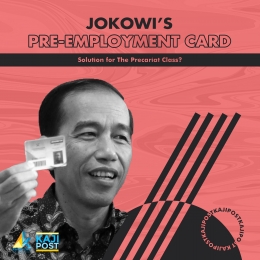In early 2020, President Joko Widodo will issue a pre-employment card[1], which is a scheme carried out by the government to provide job seekers and workers in certain conditions with incentives. These incentives come in the form of job training, certification, incentives after the job training in the form of cash, and so on.
This brings a breath of fresh air for vulnerable job seekers who are unemployed, commonly referred to as the precariat class of workers. These workers desperately need job training to improve their skills and abilities to increase productivity and efficiency in work which will indirectly increase the income of these workers. They will also receive certificates after they complete the training and pass the various test mechanisms.
These certificates of competency can be used by job seekers who get pre-employment card programs to get jobs according to their competencies. In addition, post-training incentives that participants will receive in the form of cash will be given as compensation for transportation cost, consumption cost, and internet credit cost while participating in the pre-employment card program training.
However, the implementation of pre-employment cards was questioned by many parties. Jokowi was criticized "making the wrong choice in political promotion" because it was seen by some parties as "paying" the unemployed. So, how is the pre-employment card policy implemented? And will this pre-employment card solve the problem of precariat class workers?
Paying the Unemployed?
The government through the Ministry of Manpower plans to distribute pre-employment cards which are vocational training assistance cards that will be given to jobseekers, active labor workers, and those affected by work cuts (PHK) which is expected to create increased competency. A sizeable budget of IDR 10 trillion is also provided for this program, which is expected to be distributed to 2 million participants in 2020[2], with 1.5 million participants who will be trained through digital media and the remaining 500,000 taking offline training.
However, this policy certainly is not without several requirements. For prospective applicants for this program, those who will get a pre-employment card are: 1) those who have just graduated from college or are fresh graduates but have not yet found work; 2). those who have worked but want to acquire additional skills at work; and 3) those affected by layoffs.
The immediate benefits to be obtained by pre-employment card holders include: getting job training which costs range from IDR 3-7 million, certification with the cost of up to IDR 900,000, post-training incentives of IDR 500,000 for 3 months, and a training assessment and evaluation survey that costs IDR 150,000. So, according to Indonesia's Minister of Manpower Ida Fauziah, the total benefit to be gained per participant is IDR 3.65 to 7.65 million. This policy sounds attractive to the people who are eligible to receive its benefits. Animation training, graphic design, computer, coding, baristas and various training fields will be available to be selected by prospective pre-employment card participants.
In US, pre-employment incentives has been in effect since 1935, when the United States (US) had a similar policy, Aid to Families with Dependent Children (AFDC) However, in the 1990s this welfare policy gradually had a negative impact on the country. The negative impact caused is an increase in the unemployment rate, the tendency of the population to be lazy to work, and an increase in births outside the bond of marriage
In 1996 AFDS was abolished and replaced with Temporary Assistance For Needy Families (TANF). This policy is similar to before, it's just given a deadline of 60 months. Plus, each state is given the authority to regulate its own TANF program. Still, this kind of policy has an adverse effect. The unemployed are very pleased with the large incentives from the TANF Program. This program does not motivate them to look for work, but instead wants to get more help. After 60 months, the unemployed made use of the system by asking for more help in different states. This case is known in the US as the practice of welfare-flipping.
In addition, there are also cases of unemployed people who use residential positions close to the boundaries between the two states. They will register the TANF program in two different states making it possible to get double incentives. Such cases are known as double-dipping[3].










